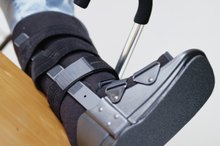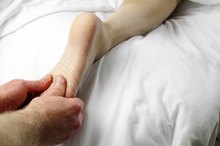Normal Range of Motion for the Great Toe
You might not think about your great toe’s function all that much, but when it does not function within its proper range of motion, you are likely to notice right away because it will lead to problems with your walking gait. If it malfunctions for long enough, it will also cause pain.
Normal Range
The upward motion for your toes is called dorsiflexion. Your great toe’s normal range of upward motion, or dorsiflexion, is 50 to 90 degrees, according to the University Foot and Ankle Institute in California. Your great, or big, toe is technically called the hallux. When you don’t have full range of motion with this toe, it is called hallux limitus.
- The upward motion for your toes is called dorsiflexion.
Effective Range
Pain in My Right Big Toe
Learn More
Your grain toe plays a role in your body’s forward propulsion when it flexes up and pushes off from the ground. To do this effectively, your great toe needs to dorsiflex to 65 degrees -- anything less than this will not help to propel your body forward effectively, causing other joints in your body to compensate for the deficiency. This can lead to an inefficient gait pattern as well as more strain on the rest of your foot and leg, and can cause pain and fatigue. You may feel this in your foot’s arch, as plantar joint pain or as plantar fasciitis, rather than in your toe itself.
- Your grain toe plays a role in your body’s forward propulsion when it flexes up and pushes off from the ground.
- You may feel this in your foot’s arch, as plantar joint pain or as plantar fasciitis, rather than in your toe itself.
Inadequate Motion Consequences
The end stage of hallux limitus is referred to as hallux rigidus, according to the Podiatry Today website. Your great toe joint becomes jammed over time due to its decrease in motion. Your toe joint suffers constant trauma in this manner, and extra bone growth happens over the top of your joint. This leads to your joint cartilage becoming eroded, which in turns leads to less motion, more pain and arthritis.
- The end stage of hallux limitus is referred to as hallux rigidus, according to the Podiatry Today website.
- Your toe joint suffers constant trauma in this manner, and extra bone growth happens over the top of your joint.
Regaining Motion
How to Increase Flexibility in My Big Toes
Learn More
If you have not reached the end stage, you may be able to regain your range of motion in your great toe with nonsurgical options like physical therapy or orthotics. This typically works in people who are younger, don’t have much history of joint degeneration and are not in much pain, notes Podiatry Today. Others are likely to need surgery.
Related Articles
References
- Podiatry Today: Key Insights On Treating Hallux Limitus
- “McGlamry’s Comprehensive Textbook of Foot and Ankle Surgery”; Alan S. Banks and Dalton McGlamry; 2001
- Valero J, Moreno M, Gallart J, et al. A new surgical procedure for hallux limitus treatment: Double-V osteotomy on the base of the proximal phalanx of the hallux. Medicine (Baltimore). 2017;96(39):e8127. doi:10.1097/MD.0000000000008127
- American Academy of Orthopaedic Surgeons. Stiff big toe (hallus rigidus). Updated October 2017.
- American College of Foot and Ankle Surgeons. Hallux rigidus.
- Cusack J, Shtofmakher G, Kilfoil RL, Vu S. Improved step length symmetry and decreased low back pain with the use of a rocking-soled shoe in a patient with unilateral hallux rigidus. BMJ Case Rep. 2014;2014. doi:10.1136/bcr-2014-206408
Writer Bio
Linda Tarr Kent is a reporter and editor with more than 20 years experience at Gannett Company Inc., The McClatchy Company, Sound Publishing Inc., Mach Publishing, MomFit The Movement and other companies. Her area of expertise is health and fitness. She is a Bosu fitness and stand-up paddle surfing instructor. Kent holds a bachelor's degree in journalism from Washington State University.









